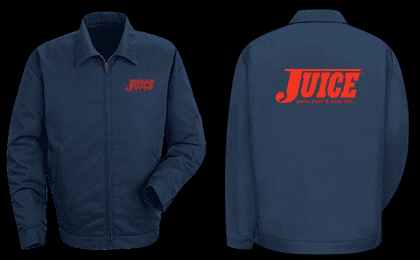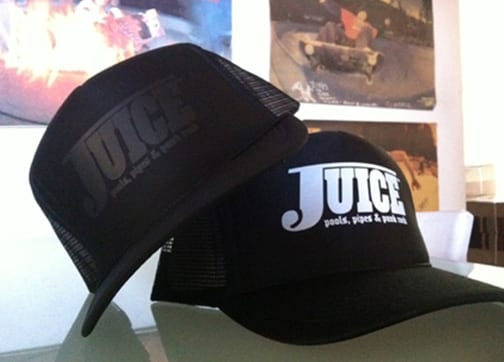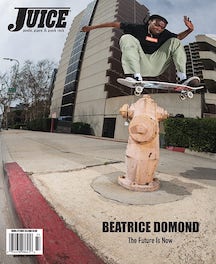“It’s very rare for a skateboarder to find himself in a situation where you have to figure out, in just a few weeks, where you can put a massive wooden bowl and find a crew of skaters to take it apart and truck it out, and then afford to rebuild it and maintain it on your property. Hank found himself in this situation after the indoor Hanger Skatepark in Charleston, South Carolina, was closing and he found out that the Hanger bowl would be demoed! Hank became the savior of the spirit of bowl riding in Charleston, preserving the legacy of Blaize Blouin and every other Southern local who were all about the flow of roundwall. With its present day home in Johns Island, SC, the wooden Hanger Bowl is still alive and relevant in the world of the concrete skatepark phenomenon. The backyard scene thrives throughout the world and we all owe Hank Biering a world of gratitude for his dedication and preservation of the life and spirit of the Hanger. Hank Biering, we salute you!” – words by Jim Murphy
Please donate and share the link to Hank’s GoFundMe to keep the Hanger Bowl going strong at https://www.gofundme.com/f/help-bieringville-bowl
Help The Hanger
Words by Indigo Smith. Photos by Grant Monahan, Dan Levy, Dave Swift, JJ Kefalas, Steve Aycock, Eric Barlow, Patrick Staley, Mark Gee, Mika, JK Wade, Kathleen Hayes, Steve Baade and Ryan Young. Video by Chuck Powell, Trey Womble, Underground Chuck, Ev Tilson, Ryps, and Zach Cusano.

The history of the legendary Hanger Bowl is not just a story, but a full-on saga. For almost 30 years, Hank Biering has put in hard work, time and materials to maintain this incredible monstrous bowl in his own backyard. Over the years, Hank and his wife, Danielle, have taken care of the Hanger and all of the people who come to visit.

Hank took on this responsibility when the Charleston skate scene needed it the most after the Charleston Hanger skatepark warehouse closed back in ‘92. In order to keep the shredding going in Charleston, the original Hanger bowl was broken down, transferred, and moved right onto Hank’s land.

In 1993, the bowl was rebuilt into what we now know as the Bieringville Bowl or the Hanger. The original Hanger was designed by Hank’s childhood friend, Blaize Blouin, alongside Tim Payne, in 1989. The Hanger stands today in Hank’s backyard in honor of Blaize (R.I.P. Blaize).
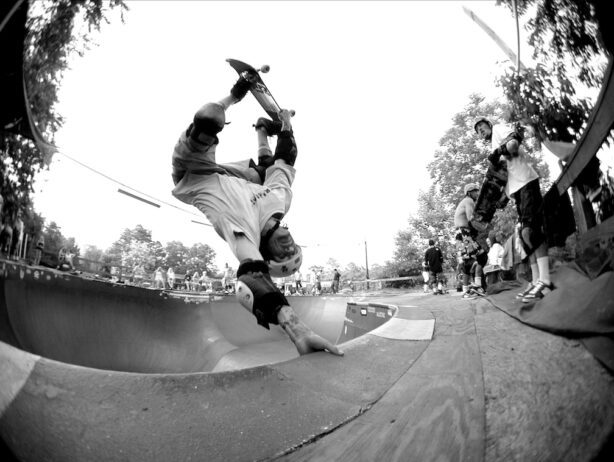
The Hanger Bowl/Bieringville Bowl has not only hosted regular sessions with its dedicated locals, but also had its coping grinded by visiting pros like Lance Mountain, Bob Burnquist, Brian Patch and Al Partanen and the Creature team, among many others, and too many East Coast skate pros and legends to list.

The Hanger Bowl has always recognized and respected skateboarding history and it pays tribute to fallen skateboarders with names stamped onto the blocks of coping around the shallow end corner, including: Blaize Blouin, Randy Lowe, Chris Bortz, Squealer, Derek McGrew, Al Carter, Dave Tuck, Drew Ridout, Kevin and Chris Lewey and Wes Ragin.

Through years of skarties and annual events that host people from all over, as well as the unpredictable harsh weather Charleston faces, this bowl now needs some lumber to rebuild the deck and relayer. The bowl has had to be maintained through hurricanes and rough storms, as well as intense humidity and salt air that causes the steel and metal to erode. The Hanger is made up of steel and Skatelite that requires frequent maintenance and adds up in price.
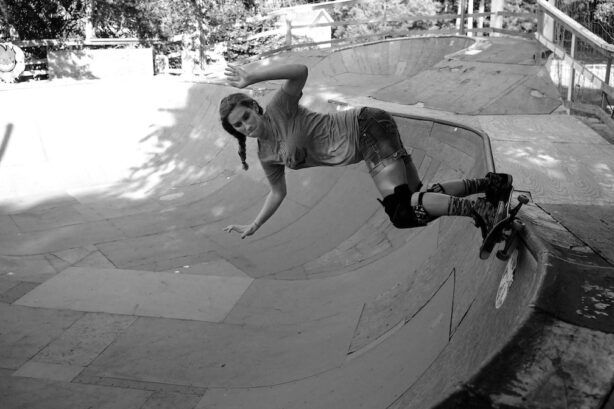
In the past, the only way Hank has gotten money for materials and repairs for the bowl has been through bowl jams and selling some shirts. Hank never reaches out for help, but this is a vital piece of skate history that deserves to be preserved.

Due to the price rise in everything since the pandemic, especially lumber, any donations are appreciated. There is an abundance of love at the Hanger/Bieringville Bowl. Now all they need is some materials to keep it going strong!

The Hanger is truly one of a kind. Thanks to Hank for taking over the responsibility of the bowl. Due to his efforts, a skate community has been cultivated over the decades that is truly a family. Despite the attempts of concrete replicas, nothing quite mirrors or beats the Hanger’s unique transition and overall energy. Please help Hank keep the famous Hanger alive and thriving by donating to the GoFundMe and sharing the link!
https://www.gofundme.com/f/help-bieringville-bowl
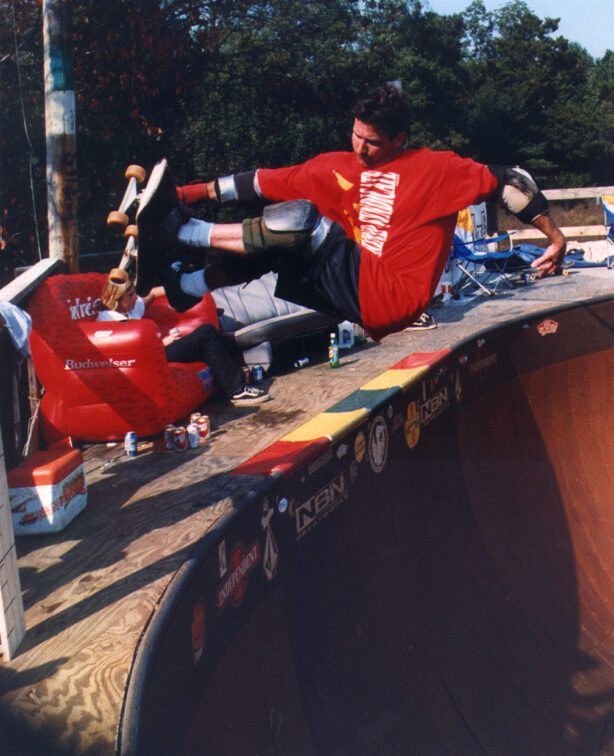
Hanger Bowl Quips & Quotes:
“The Hanger… We stole my buddy’s parents’ car in high school, pushed it out of the driveway with the engine not running and six of us crammed in it, and rode all the way to the Charleston Hanger because it was the only wooden round bowl in that era. We drove down there and skated it when it was indoors and loved it. We met Hank and Jimmy and Roller Dave and Shannon. The Hanger was the first vertical roundwall that we could lay into and it was perfect. Then we heard that it was ghost and Hank was gonna put it on his family’s land out on this island, so a bunch of us rolled back down there to help tear stuff down and do what we could do. It’s been even better outdoors than it was indoors, because it’s in Hank’s backyard and Hank is the coolest skater ever. The Hanger Bowl has been there for so long and showed so many people the bowl side of skating. Hank took so many vert heads there that loved flat wall vert ramps, but had never skated round vert. It really helped skateboarding because it has such a unique shape and it’s timeless. To have the Hanger still up and going, it’s vital. I already sent my money out to Hank and I want to help do labor too. To have the Hanger bowl backyard scene, it’s not like you’re going to your mom’s backyard. You’re going to a skater’s backyard. Hank let’s the parties happen and strangers that have never been there come in. If you’re there to skate, it’s on. I’ve been to so many Hanger Halloween Bowl jams, and people come from everywhere. There have been multiple generations of skaters coming to skate that bowl, and so many heads came out of there to go on and do other things. The Hanger paved the way for so much and it paved the way for so many and it influenced everybody in such a good way. To hold it down for almost 30 years, it’s so impressive. Hank got it right. What do you do when the park closes? You take it to your backyard. That’s what we do. We gotta keep it going. Why would we stop after so long? Wood rots out. We get it. Let’s rebuild it!” – Carlos Baiza

“Skateparks died again. Imagine that happening now. I know of a place… Hank and the Charleston locals knew that the Hanger bowl was too good to let go of. Relocation was an incredible feat and a monumental task, never mind keeping it going for 30+ years. No one can kill the backyard. No one can kill the love and devotion of a skateboarder.” – Tom Groholski

“Most functional shape ever.” – Dave “Science” Maxwell
“I sat from a distance and witnessed only what I could of the original Hanger bowl. I would study and gather as much information from the magazines and from VHS tapes that I could find on the place, observing the likes of Groholski, Blaize, and Buck Smith absolutely destroying the place with pure power of what I would assume was blatant localism! Then there was Omar and Remy … well, anyhow, I would day dream of the day I could go. Well, it came and it went, but then years later I heard of a resurrection of it in a backyard. Well, finally, I got to go.. and I’ll just say this. I felt like a shiny ornament… completely out of place… The locals were true and heavy and rode again with full authority!! Knowing every screw and nail head in the place!! Yet they fully honored and let us in… I felt it… they owned it! True stuff! Now if I get a second chance… well it would be a must for me to hold . And give it more than one day… Shit I to want to know where the damn nail heads are!” – Darren Navarrette

“I’ve spent over half my life skatin’ Hank’s and that’s where I hope to spend the rest of it.” – Bob Hart

“Charleston Hanger… summer of 1989… road trip of my life with Josh Nelson, Tom Donnelly and Bruno Herzog and the Life’s A Beach crew. We go to Charleston and the Hanger is in progress. The build is going on. We showed up and helped build the Hanger. Tim Payne is there on the project. He had just finished the Skatezone down in Atlanta. We helped him for about a week and then we go down to Atlanta and skate the Skatezone bowl. We come back to Charleston and the Hanger Bowl is done and it’s incredible. Blaize Blouin, Jimmy O’Brien and Jimmy Leaphart and all the Atlanta guys were there and it was insane. It was one of the biggest, baddest wooden bowls out there. It was big vert and shallow with a waterfall. It was an incredible build. We had an amazing session and it’s just one of the most iconic spots ever. Blaize Blouin was just incredible. He came in there and lit that bowl up like no other. I was really blessed to be there skating with my friends at one of the best bowls ever made. For the bowl to be transported to a backyard scenario, that’s what skaters do. They keep it alive. Backyard skateboarding is a really special thing. That’s why the Hanger bowl is still alive. It’s highly important to keep this bowl going because that’s the spirt of skateboarding. Bring it back to the backyard where it all started. Vertical skateboarding started in backyard pools and ramps and bowls, and it’s really important to the future of skateboarding to keep the scene going. It’s the real deal.” – Aaron Astorga
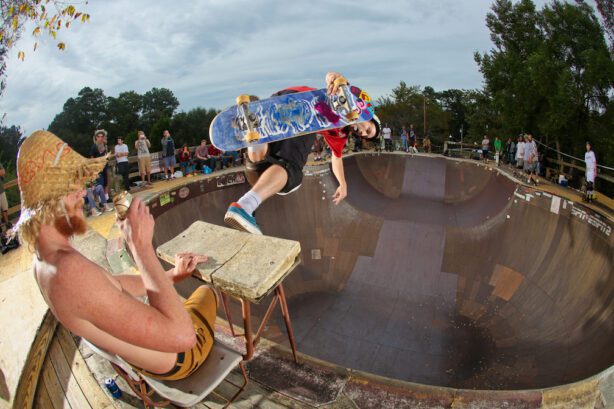
“Hank Beiring is the man who saved the Hanger Bowl the first time. Hank moved this behemoth of a bowl from The Hanger Skatepark in Charleston, SC, to his land on Johns Island in the early 90s, after the skatepark went out of business. He has dedicated his life to maintaining The Hanger Bowl, or Beiringville Bowl as it’s known by the locals. This bowl has allowed Charleston to have one of the gnarliest underground skate scenes in the country and is a major link to all skate communities in the south. At nearly 30 years old, the Charleston Hanger Bowl is in need of a new top layer of a skateable surface such as Skatelite or Gator Skins and lumber for decks and handrails. Keeping this bowl alive and skateable is preserving skateboard history.” – Zach Cusano
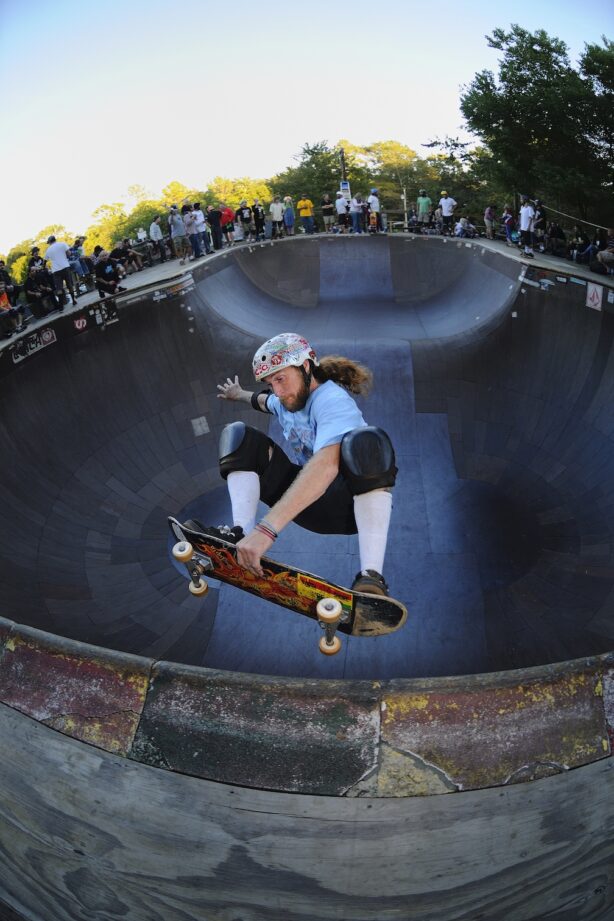
“One word to describe Hank… Genuine. Hank is a laid-back dude. Since the mid-90s, I’ve been going to Bieringville. Twice a year bowl bashes. Backyard bowls to me are important because you can get so much more out of being in the backyard than you can a skatepark. Parks don’t last forever either. Thirty years of history has been made at Hank’s. The Bieringville Bowl is like a family member. It’s a place where you can not just skate, but also break bread and get some history lessons on skateboarding, and it feels like you’re at home. Several times I have gone to Bieringville and Hank has just flowed me something. For instance, one day I needed knee pads and Hank gave me his. That right there tells you how great of a person he is. One day I had flat spot and he gave me wheels. Hank is hospitable and kind – not stingy. Hank is one of the best carpenters also and he has taught me some tricks of the trade. Love and respect to Bieringville and Hank.” – Crappie D
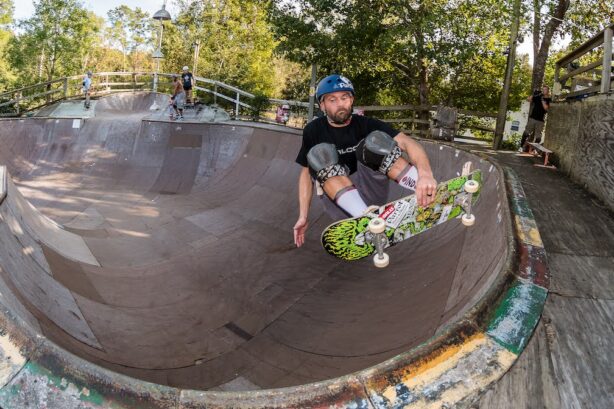
“The Hanger/Bieringville Bowl is one of a kind! One of the biggest, gnarliest, backyard vert bowls out there! I’ve seen first hand this Skatelite and steel monster humble some of the biggest name pros. For almost 30 years, Hank Biering and a crew of core locals have been maintaining and up-keeping this legendary ramp. Hank and the others I’ve met out there completely altered the trajectory of my life. This 12-foot deep backyard bowl shaped the person that I am today. I grew up skating, but I truly ‘learned to skate’ at Bieringville. No matter how much new stuff I skate, the Hanger/Bieringville Bowl remains my favorite!!!” – Josh McFadden
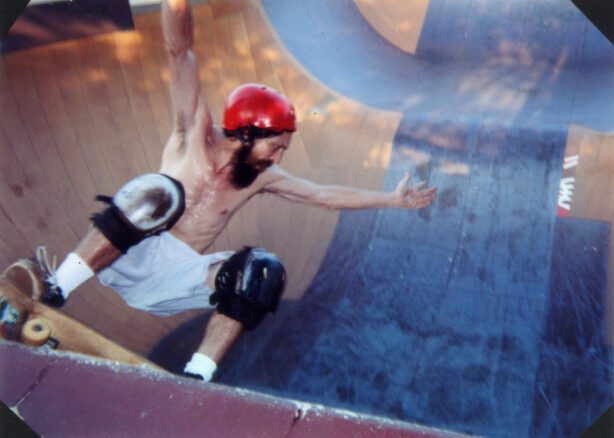
“Drop in the Deep… or go home.” – Crazy Joe
“The backyard self-made, homegrown scene was, and will always be one of, if not, the most important pillars of skateboarding. If you’re not finding, building and changing what you ride, you would only ride what they build for you.” – Dave Duncan
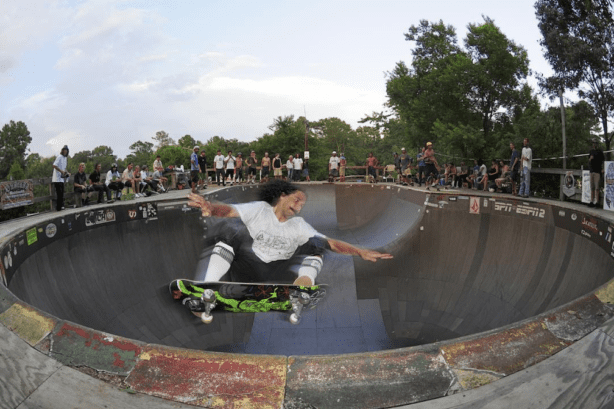
“I’ve been to the original Charleston Hanger bowl on a trip I took back there from Dallas with Tommy Kasel and Blaze Blouin. It was epic back then especially getting to skate with Blaize, probably around 1991-ish. I’ve also been to the revamp at Hank’s on an early Creature trip or maybe it was on the Saints and Sinners tour. Regardless, these epic skate structures have a history to them that goes beyond what people realize. It becomes an institution or even a way of life for some people. It changes lives. It brings people together. It’s everything. These spots are a microcosm that deserve to exist and live on into the future. Save the Hanger! – Al Partanen

“Hank was made the keeper of the bowl by the Sk8 Gods and he has made it a haven for all of us misfits.” – Shannon (Sk8mom) Smith
“I actually skated the Hanger Bowl before it got moved, so I skated it at both places. When I was still living in Indiana, we took a trip down to skate Eastern Vert and the Charleston Hanger. Those were our goals to go skate. I really liked it and I’ve got some old footage of it that I put in my ‘sponsor me’ tape back in the day. It was huge. I wasn’t used to huge round walls like that and there wasn’t really anything like it at the time. With the shallow end too, that was bowled off, it was pretty unique. It’s so important to save these historic spots. That’s what is cool about the fact that it got moved. It didn’t just disappear. That legacy kept going and it wasn’t just lost to nowhere. So many places have just disappeared. The Hanger Bowl has kept going for a long time and it would be great if it can stay around. Hats off to Hank for keeping it going. That’s awesome. – Brian Patch
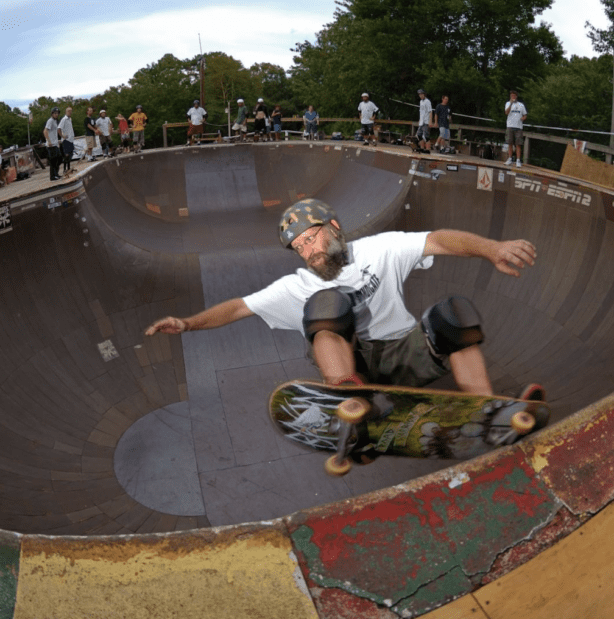
“We drug it all out here, I almost had no choice, I was born into it or something, locked into it. It’s just where it had to go, it’s really no choice, I had to keep Blaize’s backyard going, that’s pretty much what this is still.” – Hank Biering
Help the Hanger Fundraiser
Please donate to the Hanger Bowl (aka the Bieringville Bowl) in Charleston, South Carolina. Hank Biering has kept this legendary backyard bowl going for almost three decades now. This 12 ft deep above ground bowl is a piece of skate history and needs to continue to be skated and remain part of the Southeastern USA skate scene.
If you’ve ever skated, hung out in the rec area, been given a free meal, been handed a beer, attended a party, camped on the property, had your kids over to play, now is the time to give back. You can be sure Hank will put it towards the bowl; it’s one of his reasons for living! Show some love and support, and give what you can and share the link. Thank you.
https://www.gofundme.com/f/help-bieringville-bowl

Hanger Bowl Videos
Chuck Powell made this cool video of some Bieringville Bowl highlights through the years to help out with the fundraising for the Hanger Bowl.
To see where it all began, here is footage from the first pro contest at the original Charleston Hanger Skatepark in 1992 from Chuck Powell, featuring Blaize Blouin, Jimmy O’ Brien, Buck Smith, Thomas Taylor, Mike Crum, Adam Luxford, Rob Mertz, and Tom Groholski.
Here are some more recent clips of the Hanger Bowl at Hank’s thanks to Zach Cusano, Underground Chuck, Trey Womble, NicoRyper, Demonseed Skateboards, VinyardVoids, and more. Thanks y’all!
Hanger Bowl Photos

Thanks to incredible photographers, Grant Monahan, Dan Levy, Dave Swift, JJ Kefalas, Steve Aycock, Eric Barlow, Patrick Staley, Mark Gee, Mika, JK Wade, Kathleen Hayes, Steve Baade and Ryan Young. for their kindness and generosity in sharing all of these amazing images from the Hanger Bowl. We hope you’ll enjoy these photos and this interview with Hank Biering by Jim Murphy.
Hank Biering interview by Jim “Murf” Murphy
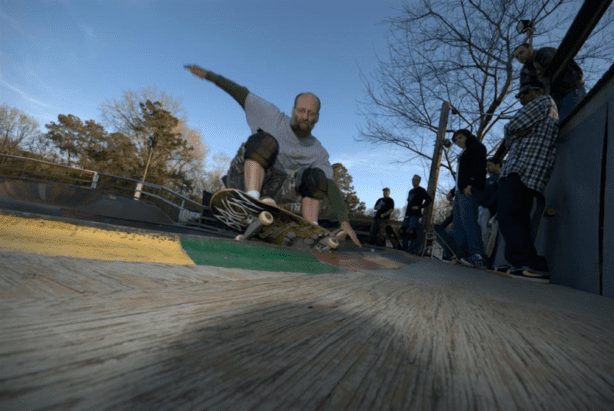
MURF: Hey, Hank. Okay, first things first. Where were you born and raised?
HANK: Charleston, South Carolina. I was born in 1966.
MURF: When did you start skating?
HANK: I was probably eight. Urethane was out, but I still had a Roller Derby with clay wheels because I was the poor kid on the block. I ended up buying Road Riders from the bike shop and putting them on my Roller Derby board. They didn’t really fit because the axles were smaller on the bigger wheels with loose bearings. I still rode it though.
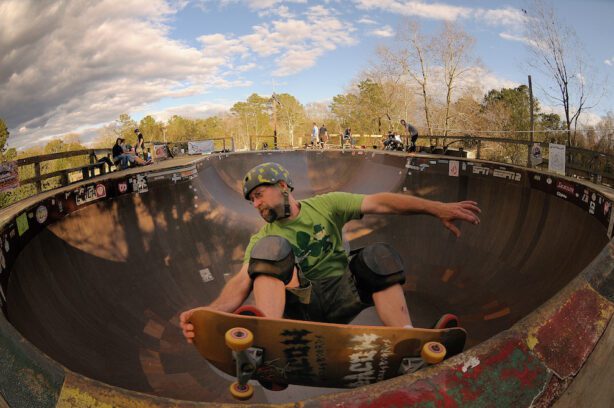
MURF: At that point, were there any skateparks around? What were you skating?
HANK: There were skateparks, but I was too young to get there. There was a park out in West Ashley and I lived in Johns Island, which was miles away. My dad dropped me off there one time and I paid my money and skated. The next time I showed up there was in high school, in the ‘80s, when I met Blaize and that skatepark was closed down. We skated it for a good while after it closed.

MURF: What did it have in it?
HANK: It was like a big Kona bowl, like a teacup bowl with extensions on both sides, like two tombstones sticking up. It had a little bowl in front of it that was down lower. You could pump around the one bowl and then over the top and around the other bowl. Eventually, the older guys tore the roof off the building, and used the wood to build a giant quarter pipe with 20-foot transitions with a foot of vert at the top. It was crazy. You could skate through the one bowl and through the other bowl and they built the quarter pipe right off the edge of the concrete. I’d ride up it on my BMX bike, but I wouldn’t ride up there on my skateboard because it had so many holes in it. That was in ’82. By ’84, that park was gone.

MURF: Was that around the time Brad Constable showed up in that area?
HANK: It is. One time he was out at that park and there was water in the bowl and he was carving around it and he fell in. It was like 20 degrees out. We showed up and he was sitting by the building, hypothermic and freezing. We had to take him to the store to get him coffee and get him warmed up. He was about to freeze to death before we showed up. He was like, “I thought I’d just carve around the water, but I fell in.” When Brad showed up, it was the first time we saw handplants in real life. I rode the school bus home with Blaize and, when we got to the backyard, Brad and Keith were there doing handplants and airs over the channel. That was stuff we hadn’t ever seen in person. It was great.
MURF: What halfpipe was that?
HANK: That was Blaize’s ramp.
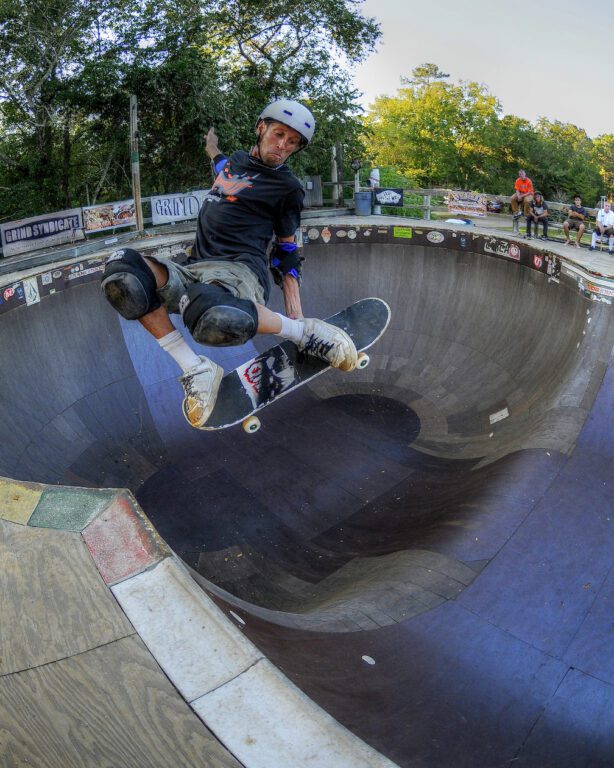
MURF: Who built that ramp?
HANK: Blaize and a couple of other guys built the first one. It was 8-foot wide. His stepdad helped him. After Brad and John Matthews showed up to the scene, we turned it the other way and made it 20-feet wide and added the channel. That’s when I started coming around and then you came and skated it. I have some old pictures somewhere in a box of me, you and Brad and Steve Herring.
MURF: That was fun. We road-tripped down there in the mid ‘80s when skateboarding was still underground. When we showed up, it was you and maybe eight hardcore skaters in Charleston, and it was on. What was the vibe living in Charleston?
HANK: Skateboarding had kind of died out after the parks closed down, so all we had to skate was Blaize’s ramp and the downtown pool. We always had it going on though. We had the hut behind the ramp and usually somebody was sleeping there, like probably me. Blaize’s mom was cool with it, so we were always welcome there. It was really cool.

MURF: I remember that Blaize started skating really well and the scene blew up. What happened in the Charleston ramp scene from the late ‘80s into the early ‘90s?
HANK: Well, Blaize moved out of his mom’s house, so we had to tear the ramp down. We took a lot of the wood out to Kevin and Chris Lewey’s house. We tried to call it Rasta Ramp 3, but those guys were metal heads and they liked AC/DC and Metallica, so they were like, “No.” They started calling it the Metal Ramp. Mike and I carried almost all of the wood out there and did all of the work out there.
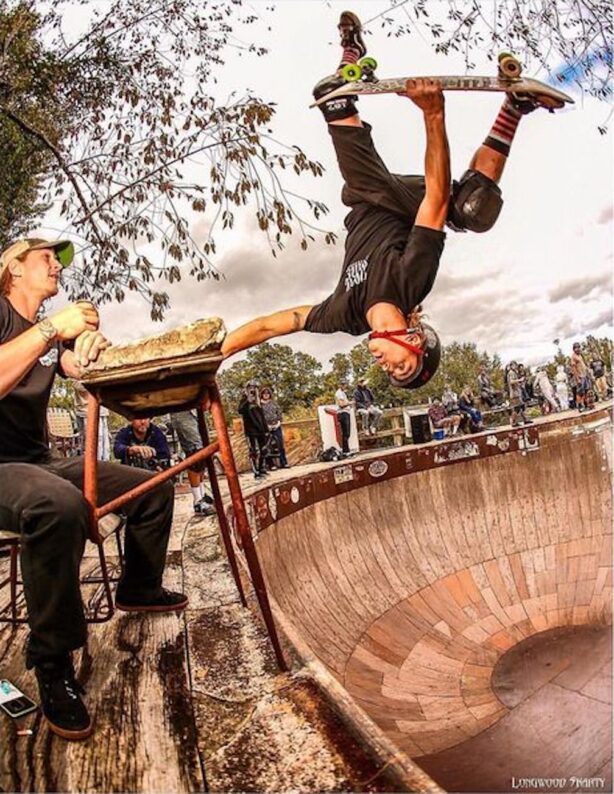
MURF: What was the transition and vert?
HANK: That was 9-foot transition with about four inches of vert. Blaize cut the transitions in his yard because we were going to build a new ramp there after we tore the old one down. Keith had a chainsaw in his hand and he was going to cut the tree limb off so that we could make the ramp bigger, but Blaize’s mom came outside and said, “You are not cutting that tree.” She was an arborist and she worked in nurseries, so she was not going to see that tree get cut, so then there was no more ramp there. Blaize already had the transitions cut out, so we took them out to Kevin and Lewey’s. We basically took their ramp and our ramp and combined it into a new ramp. We had a good run there for about three or four years. Did you ever skate that ramp?
MURF: I think I did. Was that the ramp with the masonite layer or was it 1/2 inch?
HANK: It was 1/2 inch.
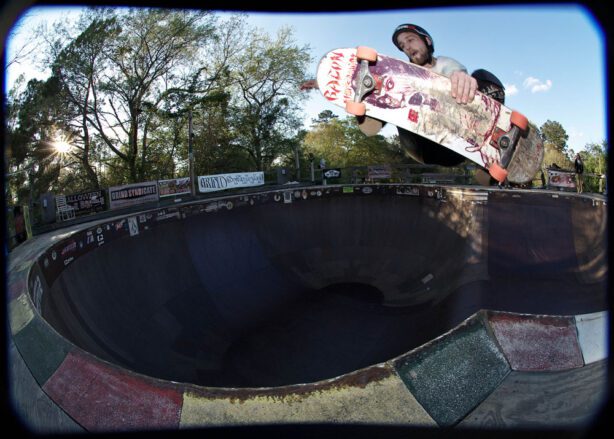
MURF: Yeah. You guys always had it going on. Do you remember people coming through, like when the Rancheros came through?
HANK: Oh yeah. They would come from Atlanta and the guys from Florida would come up. Then that ramp got torn down and everything moved over to Georgetown to Al Carter’s. That ramp was 10-foot transitions with two feet of vert and 24-feet wide with a channel and an extension and pool coping. That’s where the Grind Syndicate started with Al and Curt and Willy and all those guys.

MURF: What year was that?
HANK: That was around ’89. They always had a ramp going so, when we lost our ramp, we started going there every weekend. We always tried to help them. Blaize almost went to jail one time trying to help them. They stole a layer of plywood and they called us in Charleston and said, “We just got a brand new layer and we’re nailing it on. Get here right now!” Blaize and I started driving and, in the 30 minutes it took us to get there, the police showed up. They took a couple of those guys to jail and made them tear the whole layer off the ramp. Even though the sheets were shredded and they were going to throw it in the trash, they didn’t want us to get it.
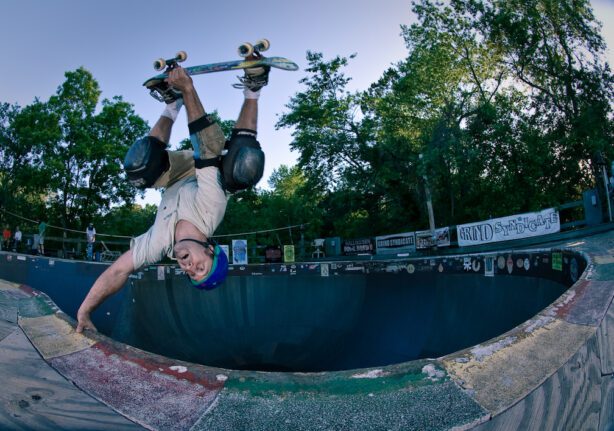
MURF: Whoa. Did they do time?
HANK: No. It was Georgetown in the ‘80s. The cops knew their parents, so they got a slap on the wrist and sent home. Jokes were probably cracked on them at every family reunion from then on.

MURF: Yeah. The downside was that you guys didn’t have a ramp anymore.
HANK: We didn’t have a ramp, but we had the pool downtown. Every girl that we knew in Charleston knew where Georgetown was though, so we had to trick a few of them. We’d say, “Let’s go to this ramp in Mt. Pleasant.” We’d get over the bridge and say, “It’s just up here a little ways.” An hour and a half later, we’d pull up to the Georgetown ramp and there would be 20 people on the deck and everyone was partying. The girls didn’t seem to care once we got there because it was such a raging scene. Once we got there, they were like, “Wow. This is cool. This is in Mt. Pleasant?” It was way out, but we’d get wicked riding there. Our whole mission every weekend was to get a ride to Georgetown to ride the ramp. In the meantime, we skated the downtown pool.

MURF: In the early ‘90s, vert skating started to die out and street skating started to take over. What was that like for you?
HANK: We were traveling around skating everything. We ended up in Morehead City, North Carolina, and a guy named Jim Rees had built a mini ramp and bowled in the corners. We were like, “We’ve got to go see this.” So we went and found it. Jim was living in a truck container on his property and he had cut doors and windows in it. He had his mini ramp and he had bowled in three of the corners. He left one corner open and he called it “The Whip”. We checked that thing out and we were like, “Man, bowled corners out of wood?” Then I started thinking, “I’m going to try to build a bowl,” so I started building a bowl here on my property. Then I was talking to Nancy [Moore] about a skatepark and then Nancy and Rich [Finch] started talking to Tim Payne. They were like, “We want to build an indoor skatepark.” I said, “Well, y’all have to build a wooden bowl. That’s the deal. Everyone is building wooden bowls. I’m trying to build one right now.” I had transitions standing out here at my place before the Hanger went up. As soon as the Hanger jumped off, I had no more help because they had the baddest indoor wooden skatepark ever built at the time.

MURF: Why did they want an indoor skatepark? What was their background?
HANK: Nancy was a good friend of ours. She’s always been a good friend to all of the skateboarders and she hung out in the punk scene and went to shows, and her dad gave her an opportunity to start a business. He was like, “What do you want to do? Here’s the money to do it.” We talked her into starting a skatepark of course. Then she was like, “What should I build?” We were like, “We need to get Tim Payne here and get everybody together and we’ll design it.” So everybody got together and designed the Hanger. They made it like the pool in San Juan Capistrano, which was the pool you used to see Alva and the boys skating. Of course, the shallow end wasn’t skateable because it had that fountain in it, but the deep end was great with the hips. Once they designed the Hanger, my bowl was shut down. My family ended up bulldozing it over after years of me skating the Hanger every day.
MURF: After the Hanger Skatepark opened up, how long was that open?
HANK: Three years.

MURF: Were you thinking from the get-go that it was going to make money?
HANK: We knew it probably wouldn’t because we had seen skateparks go down left and right, but we were just trying to get a skatepark built and she had the money to start it. We talked her into it and we laughed about it later on in life. She was like, “Why did y’all talk me into that?”
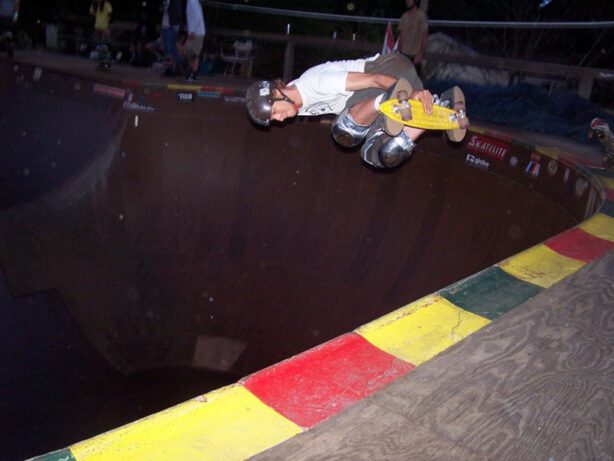
MURF: [Laughs] Describe to people what it was like when you saw Tim Payne going in there to start building the Hanger indoor skatepark. Were you on the build crew?
HANK: No. There were only a few people getting paid: Tim Payne, Mike Thorvalson and Jeff Ragin. There was Rich Finch, the owner, and Blaize Blouin, Jeff Ragin’s brother, Wes, and Drew Ridout, Robbie Moseley, David Reese and Keith Durden. Josh Nelson, Aaron Astorga and Mott were there helping some with the last layers. There were probably 20 volunteers, but I had to work my regular job to make money to pay the bills.

MURF: What was your regular job?
HANK: I’m a carpenter. I went in on the weekends and helped Tim build steps and railings, but it only took them two weeks to build the park.
MURF: Two weeks? That’s insane.
HANK: Yeah. They killed it. After the second week, they were working on the last things in the street area. The bowls were already built and layered and being painted. They built both those bowls in two weeks and most of the street too. They built a mini ramp and a bunch of other street obstacles in that time too. Right before that Tim had built the Skatezone in Atlanta. That’s where he made that mistake in the flat bottom with the little kink in the flat. When he came here, they figured out a new design that didn’t incorporate the slanted flat. That’s when they came up with the waterfall hump. That was a lot better and, with the keyhole shape, it just made sense.
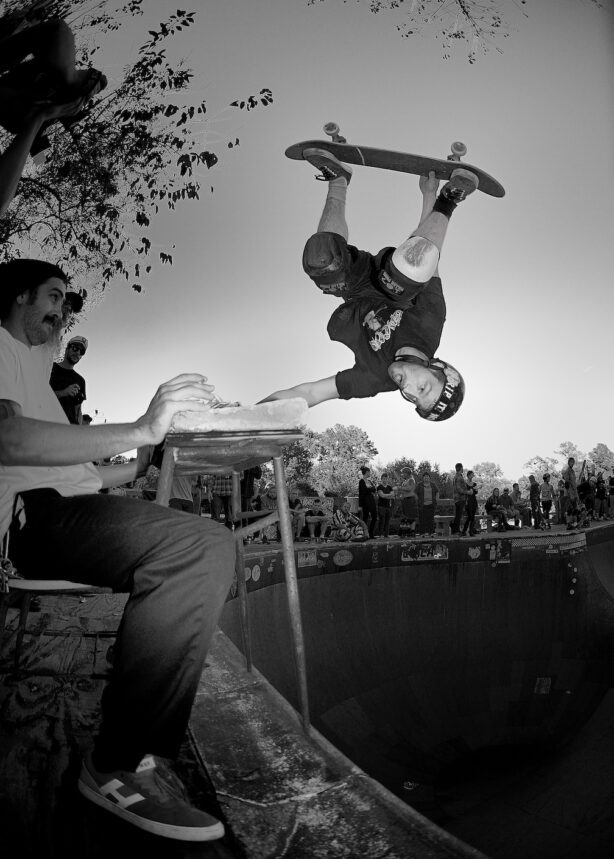
MURF: Tell me about that first day of the park being open.
HANK: Just walking in there, it was the best indoor park we had ever seen in our lives. It was all masonite and painted with this chalky paint that was as grippy as masonite can be. You still had to mop it, but it was beautiful. It was a dream come true. I drove straight there every day after work. I’d pull up and Tom Groholski and Rob Mertz would be there. They’d get Rich to open the door for them and they would skate until everyone else got off work. They’d already have doubles lines down.

MURF: Do you remember Groholski shredding?
HANK: I not only remember it, I watch it on video and study it every day. Tom Groholski is one of the best skaters in the world. The best Tom Groholski story is when we were at Kona for the 30th anniversary and we were going to see Tony Hawk skate the vert ramp. We were standing in a line 30 feet wide that went all the way around Kona’s parking lot. There was a giant group of people trying to get in the door and I hear someone go, “Hey! Hey!” I look over and Tom is standing there in the line with everybody else. I looked at him and he’s got a white bracelet on. I said to him, “You’ve got a white bracelet on. You can walk right up to the front door and walk in with all the pros.” He said, “I just want the whole experience. I’m going to wait in line with everybody else.” I thought that was cool as shit. He goes, “I’d already been in there earlier and I ducked back out and jumped in line.” He came back out because he wanted to stand in line and have the whole experience. That was pretty crazy. There were a lot of people there to see Tony Hawk.

MURF: Did Tony rip?
HANK: Yeah. It was a big vert ramp, so he ripped pretty good. He did a lot of handplants and frontside grinds, which is what gets the hoots on the East Coast. He knew what to do. I think he had on two different colored pads too. That’s not typical Tony Hawk. When in Rome, I guess…
MURF: Back to the Hanger. From ’90 to ’92, vert skating was pretty much dead, but you guys were sitting on a gold mine of a skatepark. I remember coming down there and just being like, “Skateboarding is dead, but these guys got this.”
HANK: It was a dream come true. Everyone was coming from out of town. All the guys from Daytona and all the Glug dudes and Brewce Martin, when he was a Daytona dude, would come and skate. I think Brewce and Meager burned a fire in the parking lot and got banned.
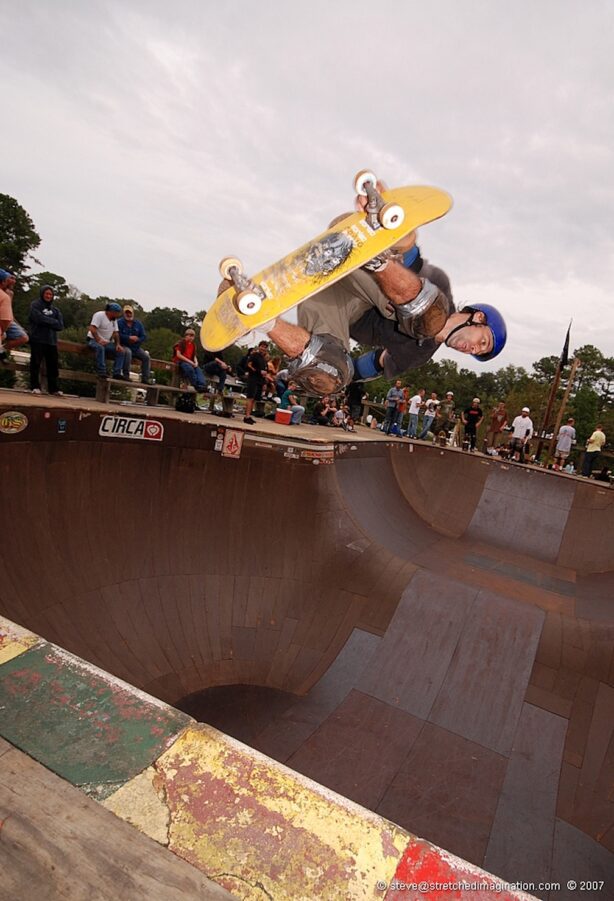
MURF: Did Adam Luxford ever show up?
HANK: Luxford lived here a while and he killed it. He was the fastest guy to ever ride the Hanger, besides Hosoi. He went 100 miles and hour and he grinded every inch of that metal pipe. He grinded all the way around one pocket and off the end of the hip and across the top of the shallow end and up the other side and over the hip and then he grinded the other pocket. He almost grinded the whole deep end, 50-50. Luxford was fast and he would go six or seven feet in the air. Once he got done going that fast, he had to do something, so he ended up with a giant air up by the ceiling.

MURF: What was that scene like when you would see all of these people coming from out of town and sessioning there?
HANK: Oh man, Chris Miller was one of the baddest. Hosoi did 8-foot tail grabs to tail in the pockets of the Hanger bowl. He transferred from bowl to bowl every run. When he dropped in, no one could skate the blue bowl because he was coming over there next. He was going to skate the whole thing. Some of the sessions with Blaize and Mike doing doubles were the best. Jeff Phillips was a ruler too. He dropped right in that thing and there was nothing he couldn’t do. He was so smooth. Just like us, he grew up skating a bunch of junky halfpipes. That bowl just made you skate good. It threw you right where you needed to be.

MURF: Did you get to hang out with Jeff at all?
HANK: Yeah. I remember one time in Alabama, me, you and him hung out under a bridge. Remember that?
MURF: Oh yeah. Wasn’t it raining?
HANK: It was raining and everyone was bummed because the ramp was getting wet. They had built a roof over the ramp, but the roof was just as wide as the ramp, so the rain came in. It was a useless roof.
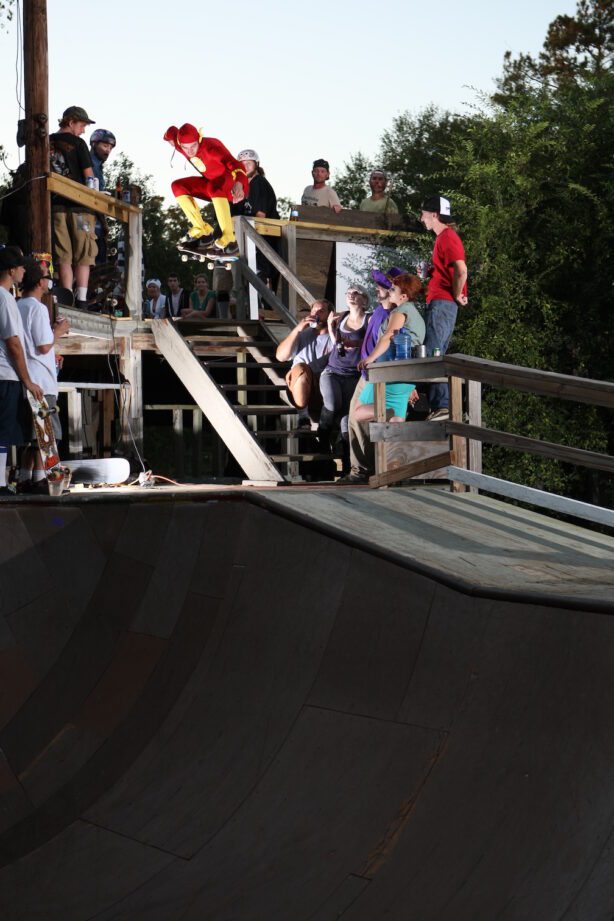
MURF: That was the Hot Tropics contest in ‘86.
HANK: Yep. They had to go so high with the roof because everybody was going to be doing airs out of it. Then it ended up raining in the sides. So, yeah, Jeff Phillips was the man at the Hanger for sure.
MURF: Remy Stratton ripped it too.
HANK: Yeah. Remy came there and ripped it. He grabbed onto the beam and swung himself all the way out into the middle of the flat and then he had to drop off all the way to the flat.
MURF: Didn’t he break his ankle or something?
HANK: Yeah. It was in some video. He was going up and trying to grab the beam and drop back. Then he grabbed one time and swung his body way out and then he was like 20 feet above the flat and there was only one way down. He had nowhere to go. There was no more transition to slide it out. He was all the way in the middle of the flat bottom. The other guy that rode that bowl really good was Lobe from Atlanta. He killed that bowl.
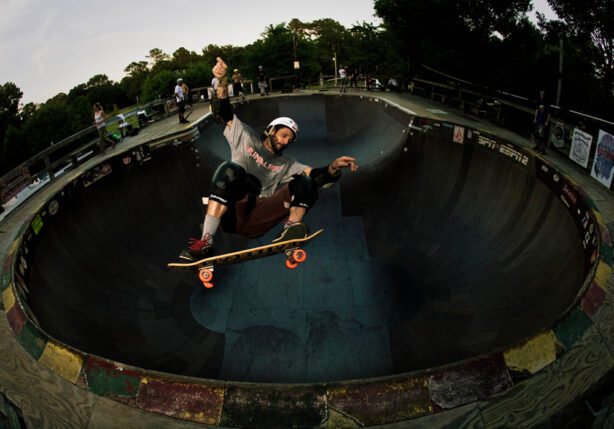
MURF: What happened when the Hanger skatepark closed and there was the transition of the Hanger Bowl over to your property?
HANK: Well, we thought they were going to try to save the bowl. They had a couple of punk rock shows and it was going good, and then they decided to close the park. I think I was the last to find out because I was the main local and no one wanted to tell me. I wondered what was going on because Morris and Brian Wainwright were in town and Jimmy Leaphart and all of these people were here. There was a big session that weekend and I just thought it was another weekend like always. Then Nancy came up to me and said, “I have to tell you, Hank. The park is closing tomorrow.”

MURF: Why were you the last one to know?
HANK: It was because I was the main one that wanted it. I was Nancy’s main friend that talked her into doing it. When she was getting ready to build it, she said to me, “I want to show you something.” We drove to Ashley-Phosphate Road where the park was and she opened up the door on the warehouse and drove into the building and there were stacks of lumber down both sides of the building. She was like, “This is going to be the new skatepark.” That’s when I knew she was really going to do it and she was really serious. When it came time to close the park, she was my friend and she didn’t want me to know until the very end because she knew how much I liked it. Immediately, Brian, Morris, Jimmy and all of us were like, “We’ve got to do something right now.” She said, “Well, I have guys coming tomorrow to price demoing it and scrapping all the wood.” We were like, “What? No. You can’t do that. What are they going to do with it?” She said, “They said that all they could probably use were the 2x4s holding up the bowl and they’re going to scrap all of the rest.” I said, “No. What can we do, Nancy?” She said, “I don’t know. I have to get this thing out of here in three weeks.” She walked off and I went around the parking lot and got everyone to give me the money they had in their pocket, which wasn’t that much. Between me and Jimmy and Morris and Brian and a couple of other folks, we came up with $450. I walked into her office and I said, “Nancy, I want to offer you $1,000 and three weeks of labor and we will demo the whole skatepark if you give us the wood.” She had already priced the demo job, so she knew she wouldn’t get that much, so she jumped on that right off the bat. I told her that I would give her the other $550 when we got it all cleared out and moved to my property. She said, “Okay.” So we killed ourselves moving everything. Carlos and a bunch of guys from Philly showed up one weekend to skate and it was over. We had torn the skatepark up, but we left the bowl until last, so we had one more session with all of the guys from Philly and the locals. Since the Blue bowl was gone, when people were flying over the hip, there was no deck or anything right there. It was just 11 feet to the concrete. It was a killer session. We skated it for hours. It was the casino effect because once you locked yourself in there, you didn’t know what time it was. When we got done skating, I was like, “Let’s cut into it right now. If we leave it up another day, we’ll just want to skate it tomorrow. Let’s cut it up right now.” So we started cutting it up into big pie pieces. We got most of it cut up that night and, when we walked outside, it was like six in the morning and the sun was coming up.

MURF: Was that wood screwed together or was it hammered in?
HANK: All the ribs were nailed in. The miters didn’t really meet the plywood real well, so we just went behind it and cut all the nails. Then we’d go to the front and run the saw and cut both layers. We had to take it apart in pie shapes. We had two big fans in the skatepark, so we traded them to the guy across the street who had a forklift. He came over and loaded all of the pieces onto the semi, so we didn’t have to lift a whole lot. Of course, we didn’t think about how we were going to get it unloaded once we got out to the property. We got it out there and there were a bunch of 4x4s that were extra from the spectator area. So we took all those 4x4s and leaned them against the side of the semi truck and we rolled the giant pieces off and let them hit the 4x4s. Even though it broke a couple of them, it broke on the seam, so we could roll it out into the field without destroying it. We had to manhandle the pieces after that. We set it all up and within a year and a half, we were skating again. We skated two layers of 1/2-inch for a little bit.
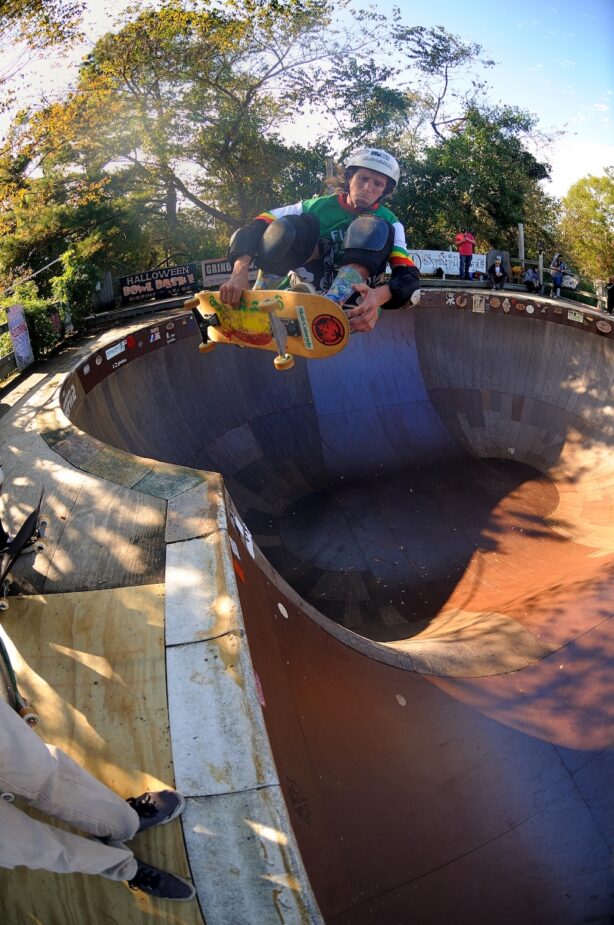
MURF: Wow. Who was that main crew when you were unloading that truck that we want to shout to right now?
HANK: It was me, Jimmy Leaphart, Todd Weldon, and this cat named Eric. Other guys were in on it, but they would come on the weekends and help. The guys from Georgetown and my buddy, Kent Smith, from Greenville would show up and pitch in. Mainly, it was the regulars, like me and Jimmy and Randy Lowe, although Randy didn’t help that much. He would just supervise. He would give us some money for wood and say, “Can I just watch?” [Laughs] Me and Randy got under that bowl and got it all screwed back together. He was like, “That was hard.” He didn’t want to help after that.
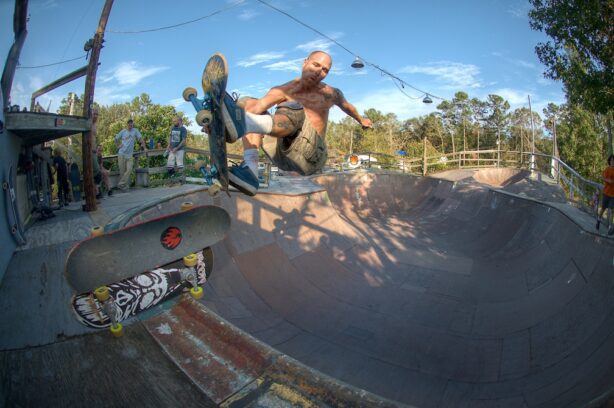
MURF: Did you make flooring for it?
HANK: Yeah. We built a floor system out of the blue bowl and the mini ramp. We got all the wood out of the Hanger, so we got the snack shack and the street area and everything. We built a platform, which was the floor system, and we set the deep end on that, and then we stood the shallow end up on 4x4s. We set it up and skated it like crazy all the way to ’99, and then we couldn’t keep up with the rot anymore. It was untreated wood because it was built indoors. In ’99, we tore the whole deep end off and burned it and poured a slab of concrete on the ground and built a whole new deep end with 10 foot transition and two feet of vert with Skatelite and steel, and, eventually, all pool coping. It’s basically like the old bowl, but on steroids.

MURF: Who was on the build crew at that point?
HANK: It was a lot of different people. Jimmy was still around, so he was good for a couple hours of work every day. He lived right across the street, so that was good. I can’t even remember all of the heads.
MURF: Up to ’99, what were the sessions like on that first bowl you had in your yard? Were people traveling there to skate or what?
HANK: Oh yeah. People were coming from all over and we had a local scene that was good too. We had our crew and Kenny’s crew with Otis. Dave Maxwell would show up in town, and Jason Wags moved here for the bowl. A few other people moved to town to skate the bowl too. At one point, in the early 2000’s, Bob Burnquist showed up with Brian Patch to skate one day.
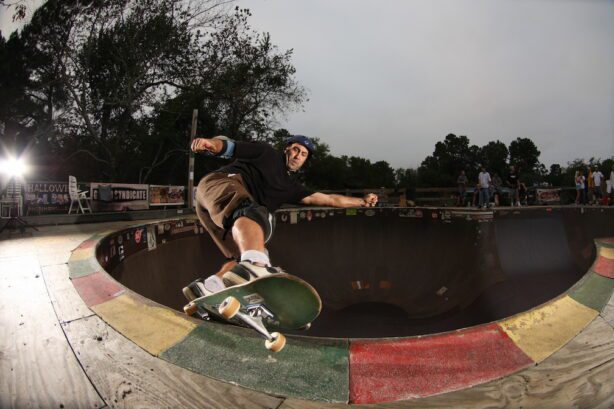
MURF: What was that session like?
HANK: Burnquist killed it. He rode it just as good backwards as anyone could ride it frontwards. I guess Jimmy and Patch had skated together in California and Patch was going to be in town and he got in touch with Jimmy and they showed up. Burnquist had been told about the bowl a lot, so he showed up. He didn’t like the mosquitos much. We were like, “What? You don’t have mosquitos in Brazil?” He was cool. He killed it. He loved the bowl. I guess the most memorable pro that showed up was Lance Mountain. That was in 2008 or 2009 and the Firm was doing a demo at a little concrete slab park behind this grocery store around here. The skate shop got them out here to do a demo, so Lance showed up with two vans full of street skaters to the demo. He had Ray Barbee with him and those guys were all touring around. He walked up and started talking to us and my friend said, “This is Hank. He owns the old Hanger Bowl.” He said, “I know. I heard. I’m going to your place when I leave here.” I said, “Well, we’re here to lead you there.” We get in the van, and Crazy Joe gets in the van with them to guide them. It started to mist rain right before we got home and I had called a bunch of people and told them we were coming, so they were all out there drying the bowl and they had towels to stand on because the deck was all wet. We had a killer session and Lance skated it until it was too dark to skate. He was still taking runs at twilight and you could hardly see. He did every trick that you know Lance Mountain can do in that bowl. He even did a sadplant and he fell over, like in that one video where he does the handplant in the grass and he falls over. He did it right in between me and Jimmy and we were like, “Whoo!” He did the fastplant and the frontal in the pocket and he did the eggplant where he flips all the way upside down and then touches the ramp on the way in. The baddest thing was The Firm video where he was skating in the dark at the Vans combi and he had drilled flint in his trucks, so when he’d grind, sparks would come out. He was riding those trucks when he came here, and none of my friends had seen that video. It was getting towards dark and his trucks were pretty worn out by that point and the flint was pretty worn out, so they weren’t sparking every time, but a couple of times, he’d just frontside grind across the flat wall and sparks shot out the back of his trucks. All my country buddies were like, “That boy ripped it so much that sparks were flying from his trucks!” [Laughs] I let them go with it for a while. Then one day we were under the bowl and Crazy Joe was telling that story about how Lance ripped the bowl so hard that sparks were flying out of his trucks, and I had to tell him, “Well, he drilled flints into his trucks.” He was like, “No. He didn’t. He’s just better than us!” I was like, “No. He drilled flints into his trucks for this video.” I had to show him the video and Joe was like, “Oh man, we just thought he was that fast!” That was a good time.

MURF: In the mid to late 2000’s, what was going on in Charleston?
HANK: It died a bit, but John Horn was living downtown and him and Bob Hart had a place and they built a bowl in their living room. It was like a 2-foot bowl in the living room and it had a chandelier hanging in the middle. Those guys liked doing ollies up onto the mantle and back into the bowl. They’d have parties and everyone was coming over and they’d have bands play. Then they wanted their living room back, so they tore that out and built a big crazy conglomeration ramp in the backyard. Actually, that ramp is still going on now.

MURF: Sick! Were you seeing a generation of kids coming out to skate your bowl and evolving into bowl skaters?
HANK: Some guys were coming out and getting better and some guys were dropping out quick. We really didn’t have a lot of a local scene for a while there. All of my older friends were getting married and having kids and all that, so there weren’t too many kids coming out. The last few years we’ve had a new surge of kids wanting to skate the bowls.
MURF: Why do you think that is?
HANK: I think it’s because of all the skateparks. Now it’s not cool to just be a street skater or just be a vert skater or just be a mini ramp skater. Now you have to skate everything. For a while, before that changed, it hurt us, because street skaters and mini ramp skaters didn’t come here. All we had was two big bowls and they considered the six-foot bowl big.

MURF: Were they scared because they knew they could get heckled too?
HANK: That was probably a lot of it. Jimmy Leaphart and Randy Lowe definitely heckled some people away. I heard that from people. They’d say, “We’d go out there and Jimmy would heckle us and hit on our girlfriends.” It scared some people away, so we quit encouraging heckling for a while.

MURF: Wow. That kind of goes against everybody’s gut, right?
HANK: It definitely goes against how I was raised because I was heckled constantly. Now we have a whole new crew of kids. Basically, their parents were friends of Randy Lowe’s and Otis and Shannon Smith. They were probably never allowed to come here when they were really young, but now that they’re a little older, they all drive out here and skate, so we’ve got a new crew that’s coming up. A lot of people have been stoked on the new public park too. They drive by it on the highway and see the pool coping and they’re like, “We better go skate some pool coping.” We’ve been getting some sessions out of that too.
MURF: Let’s talk about the new Team Pain park they built in Charleston. Was that planned for a good while?
HANK: I don’t know the exact years, but then Pour It Now came here and got together with Shannon Smith who had already been pushing for the park.

MURF: What is Pour It Now?
HANK: It’s an organization that would go to a town and try to get the funding to get a park going. In other words, “Pour a skatepark now in your town.” They were in Columbia, South Carolina, trying to get their skatepark built. Then, when Corey Dowd was skating with his brother, Cheyne, and he got pushed down by the police here in Charleston, there was a big controversy about it. The Pour It Now guy saw that and thought if he came here that he could help get a skatepark built here. Meanwhile, he went back to Columbia and they built their park. Shannon then took over the push for the park here in Charleston and talked the city into matching whatever we could raise. They had punk shows and bake sales and Shannon got the parents at her schools to scratch off checks and, within a few years, they raised a million dollars. We’d go to all the events and donate and we did everything we could to support it. Then the city had to build a $2,000,000 park. It’s cool because it’s right on the marsh and it’s got a killer view.

MURF: What is it like as far as the design goes? Were you involved with that at all?
HANK: We made suggestions and they knew we wanted some sort of clover-type pro bowl, so that came to pass. That was a suggestion I made a long time ago because we could get more bowls for the money. Then they wanted a mini bowl because everyone loves the mini bowl here, so they built a mini bowl and then the snake run was what everyone wanted. We were even willing to give up the mini bowl, if we had to, in order to get the snake run. They ended up building a snake run into a 9 foot deep tile and pool coping pool, so we got way more than we asked for with that.

MURF: Wow! Is that a gradually sloping snake run, downhill style?
HANK: It gets deeper as it goes down, but the terrain is level. There are really no hills in downtown Charleston. It’s a slight grade and it gets deeper and deeper as it goes towards the 9-foot deep end. The tombstone is 10 and 2. They built this tombstone looking thing like Kona. It’s the only 10-foot wall in the park. It’s a tribute to Kona and to us because we wanted something that was 10 and 2. There are a couple of cool moguls in the snake run too. It’s fun.

MURF: Killer. Well, as the owner of the Hanger bowl, with all of the history of that bowl and all of the people that have ridden it and praised it, what is it like to wake up and know that you have that bowl out there?
HANK: It’s what I’ve lived for. It’s what I did everything for. I worked to raise my daughter and to get this bowl going for everybody. We didn’t have anything to skate, so my mission just turned into an addiction to build. My mission was to have something for everyone to skate. When Blaize was around, we always had a backyard ramp and we’ve always kept that going. Once the Hanger was going to close, I freaked out. We had to have something to skate and we had to do it. By then, I had plenty of experience building. I’ve built ramps and houses and a couple of skateparks, so I was ready to do it, and we’ve kept it going since then.
MURF: Sick! What is your Duty Now For the Future?
HANK: I just want to keep it going out here. Even with the new park, people still want to skate out here where they can do what they want and have some beers on the deck, so we still have sessions out here.

MURF: Your place is always going to be the place where everyone can hang and do what they want. You’re sitting on history. I’m proud of ya.
HANK: This is all I know.
MURF: Keep doing it, Hank. Is there anyone you want to thank?
HANK: Shout outs to Blaize Blouin! He was the inspiration for it all for me.

MURF: Well, you’ve been doing it for a long time and it’s impressive.
HANK: You’re doing it, Murf. You’re Jim Murphy. You came to town and showed us shit we’d never seen. New Jersey was our influence too. It really was. Brad brought y’all there and that’s where Blaize learned, and me and my buddy, Chris Phelps. Between Richmond and here, it was the Jersey influence coming South.
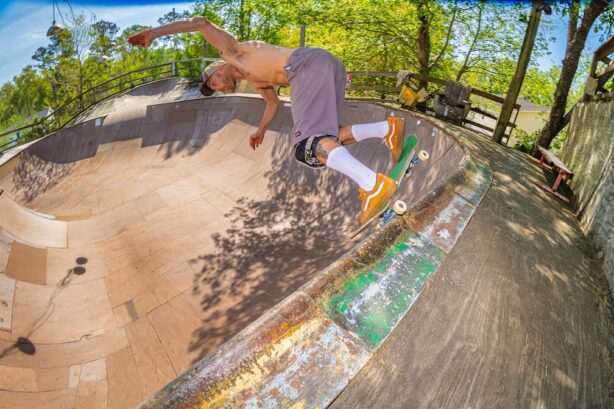
MURF: You had Groholski too.
HANK: Oh yeah. Tom was a total influence. Randy Lowe, that’s all he skated was Tom Groholski boards. He had the Vision going and the little devil one. I still have some Groholski boards here.

MURF: Hell yeah, Hank. We’re one big family. I have the greatest memories of hanging with you back in the day and up until now and we look forward to seeing you again.
HANK: Well, we will be here ready to rip.

MURF: Right on. Thanks for your time, Hank.
HANK: It was good talking to you.
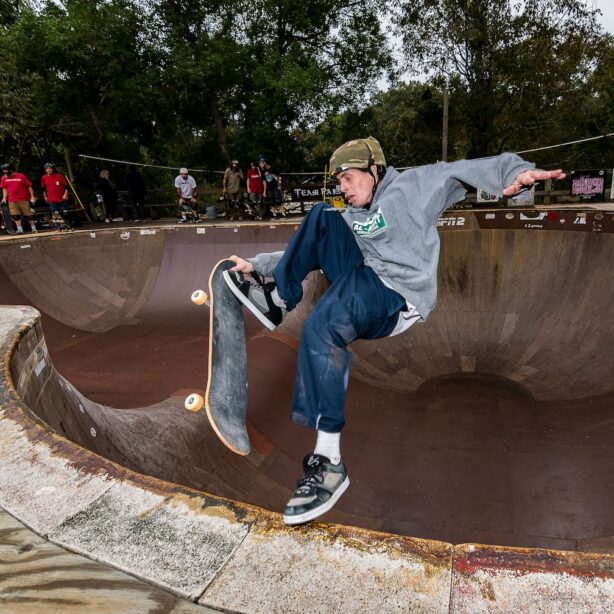
MURF: It was good talking to you. Hang in there and keep doing what you do.
HANK: You too, man. I’ll see ya when you get here.



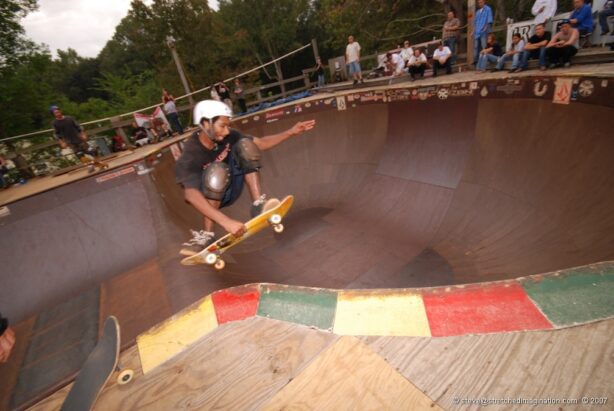

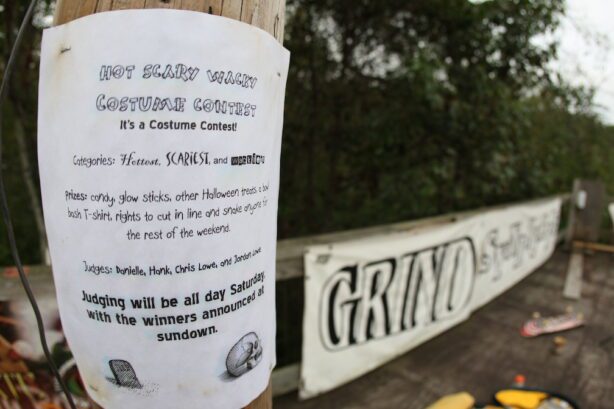




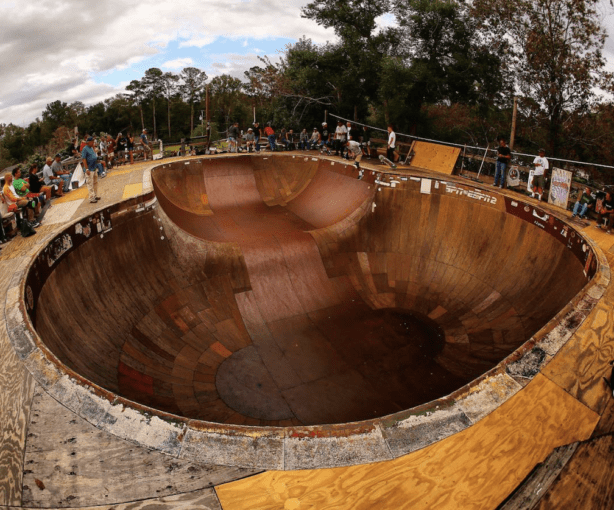
SHARE THIS POST:
- Click to email a link to a friend (Opens in new window)
- Click to share on Tumblr (Opens in new window)
- Click to share on LinkedIn (Opens in new window)
- Click to share on Pinterest (Opens in new window)
- Click to share on Twitter (Opens in new window)
- Click to share on Facebook (Opens in new window)
- Click to share on Reddit (Opens in new window)
- Click to print (Opens in new window)




